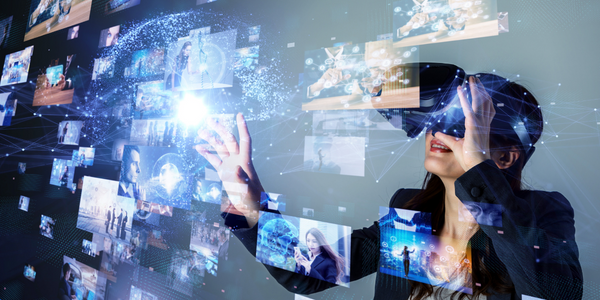Virtual Reality

Virtual reality technology uses a computer to create a three-dimensional virtual space. It provides users with the simulation of visual, auditory and tactile senses so that users can observe things in the three-dimensional space in time and without restrictions as they experience the situation substitute human consciousness into a virtual world.Currently, the Virtual Reality can be used in manufacture, healthcare, automotive, space, military and law enforcement, and entertainment industry by providing job training or new ways of introducing an audience to a concept or experience.
Enhanced Customer Experience: Virtual reality offers businesses the opportunity to create immersive and engaging experiences for customers. Companies can use VR technology to showcase products and services in a realistic and interactive virtual environment, allowing customers to explore and interact with them before making a purchase decision.
Training and Education: VR has revolutionized training and education by providing immersive learning experiences that simulate real-world scenarios. Businesses can use VR simulations to train employees in various industries, such as healthcare, manufacturing, and aviation, improving learning outcomes and reducing training costs.
Product Design and Prototyping: VR enables businesses to streamline the product design and prototyping process by creating virtual prototypes and conducting virtual design reviews. Designers and engineers can collaborate in a virtual environment to visualize and iterate product designs, resulting in faster time-to-market and reduced development costs.
Customers: Customers are key stakeholders in VR initiatives, as they are the end users who interact with VR experiences created by businesses. They expect immersive and engaging VR content that enhances their shopping experience, provides valuable information, and helps them make informed purchasing decisions.
Employees: Employees are important stakeholders in VR applications for training and education. They rely on VR simulations to acquire new skills, improve performance, and enhance safety in the workplace. VR training programs empower employees to learn by doing in a risk-free virtual environment.
Investors and Partners: Investors and partners are interested stakeholders in VR projects, as they provide funding and support for the development and deployment of VR solutions. They evaluate the potential return on investment (ROI) and strategic value of VR initiatives, considering factors such as market demand, competitive landscape, and technological feasibility.
Head-Mounted Displays (HMDs): VR technology relies on head-mounted displays (HMDs) that provide immersive visual and auditory experiences to users. HMDs incorporate high-resolution displays, audio systems, and motion tracking sensors to create realistic virtual environments.
Motion Tracking Systems: VR systems use motion tracking technology to accurately track the movement and position of users within virtual environments. Motion tracking systems include cameras, sensors, and infrared emitters that capture real-time movement data and translate it into virtual actions.
User Interaction Data: VR applications generate user interaction data that provide insights into user behavior, preferences, and engagement levels. Businesses can analyze this data to optimize VR experiences, personalize content, and improve user satisfaction.
Performance Metrics: VR systems capture performance metrics related to system performance, latency, frame rate, and graphical fidelity. These metrics are essential for evaluating the technical performance of VR applications and ensuring a smooth and immersive user experience.
Hardware and Software Integration: Deployment of VR solutions requires careful integration of hardware and software components to ensure compatibility and performance. Businesses select VR headsets, motion controllers, tracking systems, and software platforms that meet their specific requirements and use cases.
Content Development and Distribution: Deployment of VR content involves the creation, distribution, and management of immersive experiences for end users. Businesses collaborate with content developers, 3D artists, and VR studios to create high-quality VR content and distribute it through various channels, such as VR app stores and online platforms.
Case Studies.







